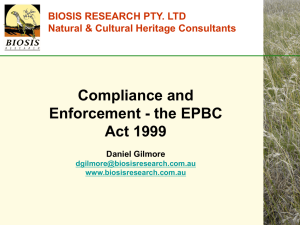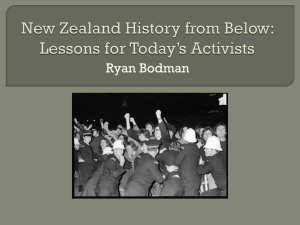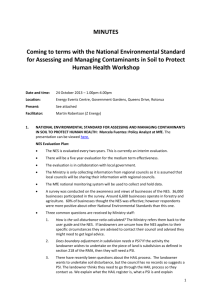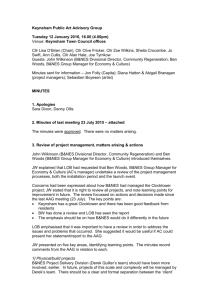11_45am James Corbett NES NZIEH2012 Final
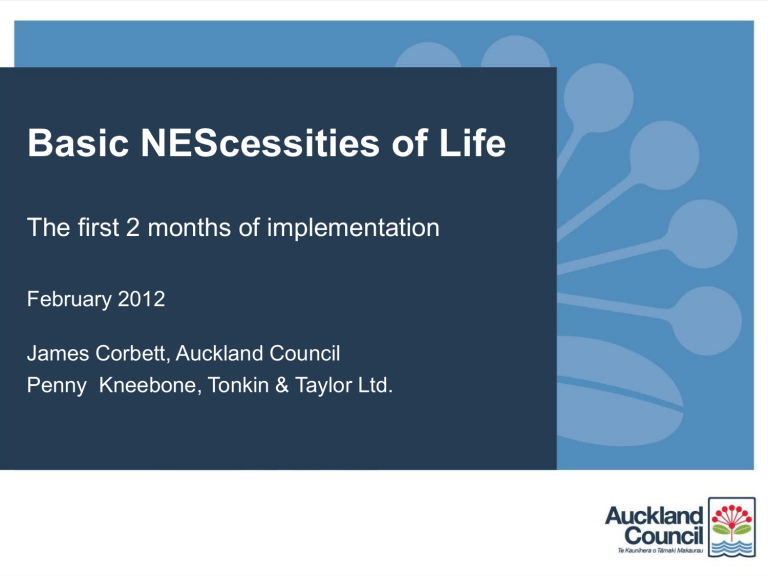
Basic NEScessities of Life
The first 2 months of implementation
February 2012
James Corbett, Auckland Council
Penny Kneebone, Tonkin & Taylor Ltd.
Abstract
The new Auckland Council is assessing how the contaminated land rules for each of the seven legacy district council plans and the regional plan can be amalgamated. That process now needs to account for the introduction of the proposed National Environmental Standard for Assessing and Managing
Contaminants in Soil to Protect Human Health (NES), introduced in January
2012.
• This paper reviews the impact the NES is likely to have on policy, regulation and operations.
• Does the NES clarify the management of land contamination?
• Does it make consenting easier, or more complex?
• Is it likely to result in more remedial works or less?
• What issues have arisen for Council and contaminated land practitioners?
• Discussion of EHO experiences with the NES to date.
Outline
Auckland Council
NES and its application
The first 2 months: Auckland
Council, consultants, EHOs
Discussion
Auckland Council - A Unified Future with the NES
Pre Auckland Council
Waitakere
Auckland
City
Rodney
Papakura
Franklin
North
Shore
Manukau
Auckland
Regional
• 1 Regional Plan
• 7 Territorial/City Plans
Auckland
Council today
Unitary
Council
Auckland Council of future
NES
UNITARY PLAN
Size & Complexity
Largest Council in Australasia
About 8,500 staff
Over 1.4M served
Specification: Policies, Plans
Delivery: Enforcement,
Services
Service
Delivery
Auckland
Council
Service
Specification
Land Contamination
Specialists
Operations
(LCPM)
Regulatory
(Regional &
Territorial)
Policy
(Spatial Plan &
Unitary Plan)
Land Management Operations
Parks, Stormwater, Property, others
CCOs e.g. ACPL, WDA, AT
What does the NES do?
• Protects Human Health
• Appropriate identification and assessment of contaminated land before it is developed
• TAs to give effect to/enforce
• Overlay plan chapter
• Imposes timing / costs
• Requires more information
– May not be welcome in areas where information requirements or rules have been less visible
• Not retrospective
• Rapid introduction - surprised?
Main changes
• Nationally consistent planning controls
• Nationwide Soil Contaminant
Values
• Activity categories; triggers for activities
• Information baseline
• Incorporates Guidelines by reference
Consultant issues in first 2 months
• PSI/DSI o suitably qualified environmental professional o cost estimates
• Rules interpretation
– Change in land use e.g. drycleaner changing to a takeaway
– Production land e.g. fruit processing plant on orchard
– Early discussions with Council to confirm activity status and information requirements
• Review previous assessments
Council impacts in first 2 months
• Training
• Process - mapping; no integration;
Planners identify NES application;
EHOs status
• Operational policies – reject where no reference to NES
• Communication – between departments; customers
• Information management: resources, legacy systems
• Issues
– Alternate methods – discr default
– Conflict Regnl Rules Tank pulls
– Default land use categories
EHO issues in first 2 months
Q’s, Confusions, Conspiracies:
• Are you coping with the change?
• What don’t you get?
• What would you like assistance with?
• Where do you see the greatest challenges?
• What experiences can you tell us all about?
• Any tips?
CASE STUDIES
Case Study: Omana Sheep Dip
• About 15m long, 1m wide and 1.5m deep
• a few metres from the beach at Maraetai
• Historically significant feature
• Used in the 1930s
• High use reserve
Case Study: Omana Sheep Dip
• Investigations
– Preliminary Region-wide
Sheep Dip Study
– Detail Site Investigation
• Contaminants
– Arsenic
• Remedial Works
– Temporary fencing
– Removal of contaminated material
Case Study: Omana Sheep Dip
Case Study: Omana Sheep Dip
As
(mg/kg)
2,290 Max
80
100
Auckland City
NES
Remediation
• Work plan unlikely to have been changed
Consent required
• Restricted discretionary for works near tree & stream
• Restricted discretionary for disturbance & exceeding
SCS
Case Study: Stokes Point
• Investigations
– Preliminary Soil Sampling
– Detailed Site Investigation
– Human Health Risk
Assessment
• Contaminants
– Lead
– BaP
• Remedial Works
– Temporary fencing
– Hot spot isolation
Case Study: Stokes Point
Case Study: Stokes Point mg/kg
Lead
BaP
Max
840
83
Mean 95% UCL ACC
162 220 600
7.1
10 2
HHRA
4,000
21
NES
880
40
No gross contamination
Hotspots concentrations were too high to disregard
NES would not have changed the work plan
If lead concentrations had been higher, the NES would have required extensive remediation
Conclusion
• The NES will enable Auckland Council to more effectively manage human health risks consistently across the region
• Key factors for success include:
– information management,
– process integration,
– training
• Cost impact on remediation programme
– potentially minimal for most contaminants
– HHRA for default land use categories increases cost

